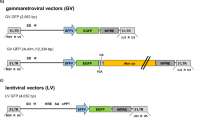Abstract
Ataxia Telangiectasia (A-T) is an autosomal recessive disease caused by loss of function of the protein kinase ATM. Atm-deficient mice display several phenotypes consistent with the human disease, including predisposition to cancer, growth retardation, cell-proliferation defects and infertility. A-T patients have a several hundred fold increased risk of developing lymphomas and leukemias, which are typically highly invasive. By reducing homologous recombination through genetic deletion of the Rad52 protein, we were able to decrease substantially the development of T-cell lymphomas in Atm−/− mice, resulting in an increased life span of the double mutant mice. Additionally, we were able to partially rescue the T-cell development of Atm−/− mice. Other phenotypes, including growth defects, genomic instability, infertility and radiosensitivity, were not rescued. Our results suggest that excessive recombination is an important contributor to tumorigenesis in A-T.
This is a preview of subscription content, access via your institution
Access options
Subscribe to this journal
Receive 50 print issues and online access
$259.00 per year
only $5.18 per issue
Buy this article
- Purchase on SpringerLink
- Instant access to full article PDF
Prices may be subject to local taxes which are calculated during checkout



Similar content being viewed by others
References
Barlow C, Hirotsune S, Paylor R, Liyanage M, Eckhaus M, Collins F, Shiloh Y, Crawley J, Ried T, Tagle D and Wynshaw-Boris A . (1996). Cell, 86, 159–171.
Baynton K, Otterlei M, Bjoras M, Von Kobbe C, Bohr VA and Seeberg E . (2003). J. Biol. Chem, 278, 36476–36486.
Bishop AJ, Barlow C, Wynshaw-Boris AJ and Schiestl RH . (2000). Cancer Res., 60, 395–399.
Bishop AJ, Hollander MC, Kosaras B, Sidman RL, Fornace Jr AJ and Schiestl RH . (2003). Cancer Res., 63, 5335–5343.
Chakraverty RK and Hickson ID . (1999). Bioessays, 21, 286–294.
Essers J, Hendriks RW, Swagemakers SM, Troelstra C, de Wit J, Bootsma D, Hoeijmakers JH and Kanaar R . (1997). Cell, 89, 195–204.
Gao Y, Sun Y, Frank KM, Dikkes P, Fujiwara Y, Seidl KJ, Sekiguchi JM, Rathbun GA, Swat W, Wang J, Bronson RT, Malynn BA, Bryans M, Zhu C, Chaudhuri J, Davidson L, Ferrini R, Stamato T, Orkin SH, Greenberg ME and Alt FW . (1998). Cell, 95, 891–902.
Germain RN . (2002). Nat. Rev. Immunol., 2, 309–322.
German J . (1993). Medicine (Baltimore), 72, 393–406.
German J . (1995). Dermatol. Clin., 13, 7–18.
Jackson SP . (2002). Carcinogenesis, 23, 687–696.
Kagawa W, Kurumizaka H, Ishitani R, Fukai S, Nureki O, Shibata T and Yokoyama S . (2002). Mol. Cell, 10, 359–371.
Lee Y, Barnes DE, Lindahl T and McKinnon PJ . (2000). Genes Dev., 14, 2576–2580.
Lisby M, Mortensen UH and Rothstein R . (2003). Nat. Cell Biol., 5, 572–577.
Liyanage M, Weaver Z, Barlow C, Coleman A, Pankratz D.G, Anderson S, Wynshaw-Boris A and Ried T . (2000). Blood, 96, 1940–1946.
Luo L, Lu FM, Hart S, Foroni L, Rabbani H, Hammarstrom L, Yuille MR, Catovsky D, Webster AD and Vorechovsky I . (1998). Cancer Res., 58, 2293–2297.
Meyn MS . (1993). Science, 260, 1327–1330.
Mohaghegh P and Hickson ID . (2001). Hum. Mol. Genet., 10, 741–746.
Petiniot LK, Weaver Z, Barlow C, Shen R, Eckhaus M, Steinberg SM, Ried T, Wynshaw-Boris A and Hodes RJ . (2000). Proc. Natl. Acad. Sci. USA, 97, 6664–6669.
Petiniot LK, Weaver Z, Vacchio M, Shen R, Wangsa D, Barlow C, Eckhaus M, Steinberg SM, Wynshaw-Boris A, Ried T and Hodes RJ . (2002). Mol. Cell. Biol., 22,3174–3177.
Rijkers T, Van Den Ouweland J, Morolli B, Rolink AG, Baarends WM, Van Sloun PP, Lohman PH and Pastink A . (1998). Mol. Cell. Biol., 18, 6423–6429.
Sekiguchi J, Ferguson DO, Chen HT, Yang EM, Earle J, Frank K, Whitlow S, Gu Y, Xu Y, Nussenzweig A and Alt FW . (2001). Proc. Natl. Acad. Sci. USA, 98, 3243–3248.
Sigurdsson S, Van Komen S, Petukhova G and Sung P . (2002). J. Biol. Chem., 277, 42790–42794.
Singleton MR, Wentzell LM, Liu Y, West SC and Wigley DB . (2002). Proc. Natl. Acad. Sci. USA, 99, 13492–13497.
Solinger JA, Kiianitsa K and Heyer WD . (2002). Mol. Cell, 10, 1175–1188.
Symington LS . (2002). Microbiol. Mol. Biol. Rev., 66, 630–670 table of contents.
Tsuzuki T, Fujii Y, Sakumi K, Tominaga Y, Nakao K, Sekiguchi M, Matsushiro A, Yoshimura Y and Morita T . (1996). Proc. Natl. Acad. Sci. USA, 93, 6236–6240.
Wang Y, Elson A and Leder P . (1997). Proc. Natl. Acad. Sci. USA, 94, 14590–14595.
Wong KK, Maser RS, Bachoo RM, Menon J, Carrasco DR, Gu Y, Alt FW and DePinho RA . (2003). Nature, 421, 643–648.
Acknowledgements
We thank A Pastink for providing Rad52−/− mice. Special thanks go to M. McConnell and J. Chun for SKY analysis of MEFs and helpful discussions. K.T. is supported by the Deutsche Forschungsgemeinschaft. This work was supported by NIH Grants NS39601 and financial support from the Charles H and Anna S Stern foundation and The V-Foundation for cancer Research to CB.
Author information
Authors and Affiliations
Corresponding author
Rights and permissions
About this article
Cite this article
Treuner, K., Helton, R. & Barlow, C. Loss of Rad52 partially rescues tumorigenesis and T-cell maturation in Atm-deficient mice. Oncogene 23, 4655–4661 (2004). https://doi.org/10.1038/sj.onc.1207604
Received:
Revised:
Accepted:
Published:
Issue date:
DOI: https://doi.org/10.1038/sj.onc.1207604
Keywords
This article is cited by
-
DNA replication machinery prevents Rad52-dependent single-strand annealing that leads to gross chromosomal rearrangements at centromeres
Communications Biology (2020)
-
Mutational signatures reveal the role of RAD52 in p53-independent p21-driven genomic instability
Genome Biology (2018)
-
USP48 restrains resection by site-specific cleavage of the BRCA1 ubiquitin mark from H2A
Nature Communications (2018)
-
More end resection is not merrier
Nature Structural & Molecular Biology (2016)
-
DNA-damage repair; the good, the bad, and the ugly
The EMBO Journal (2008)



